Abstract
To help elucidate the general rules of equilibrium globular protein folding, dynamic Monte Carlo simulations of a model beta-barrel globular protein having the six-stranded Greek key motif characteristic of real globular proteins were undertaken. The model protein possesses a typical beta-barrel amino acid sequence; however, all residues of a given type (e.g. hydrophobic residues) are identical. Even in the absence of site-specific interactions, starting from a high-temperature denatured state, these models undergo an all-or-none transition to a structurally unique six-stranded beta-barrel. These simulations suggest that the general rules of globular protein folding are rather robust in that the overall tertiary structure is determined by the general pattern of hydrophobic, hydrophilic, and turn-type residues, with site-specific interactions mainly involved in structural fine tuning of a given topology. Finally, these studies suggest that loops may play an important role in producing a unique native state. Depending on the stability of the native conformation of the long loop in the Greek key, the conformational transition can be described by a two-state, three-state, or even larger number of multiple equilibrium states model.
Full text
PDF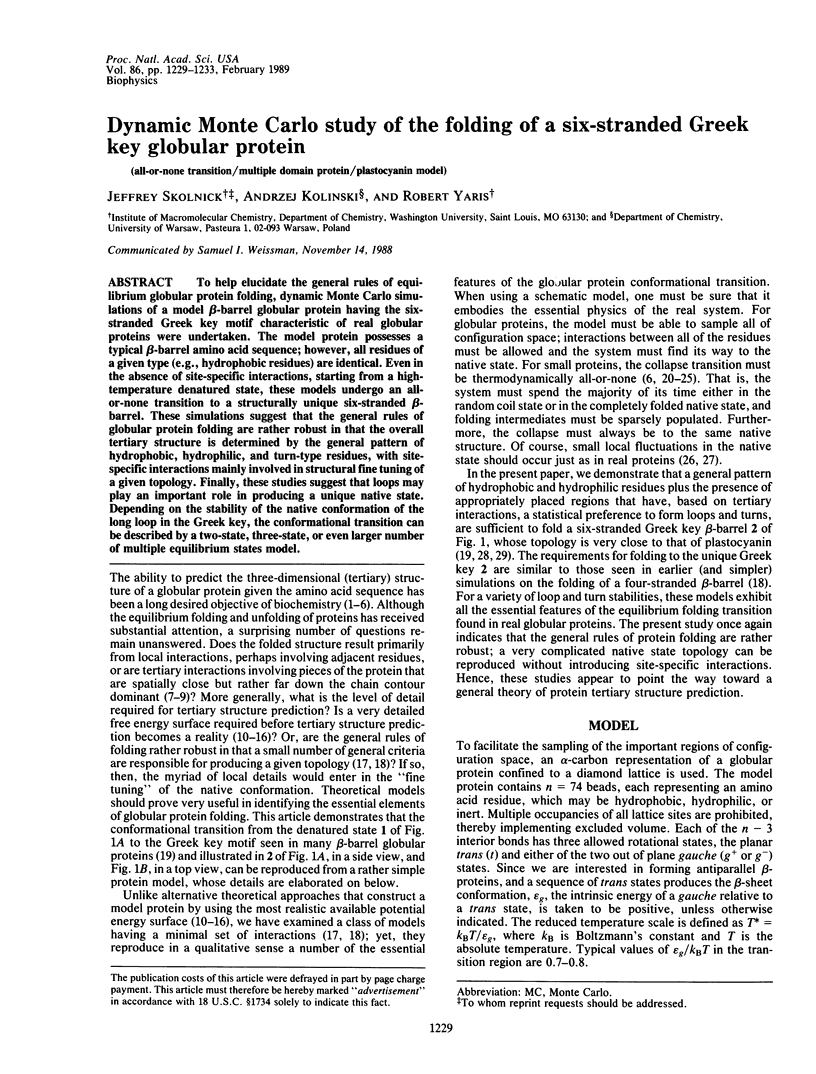
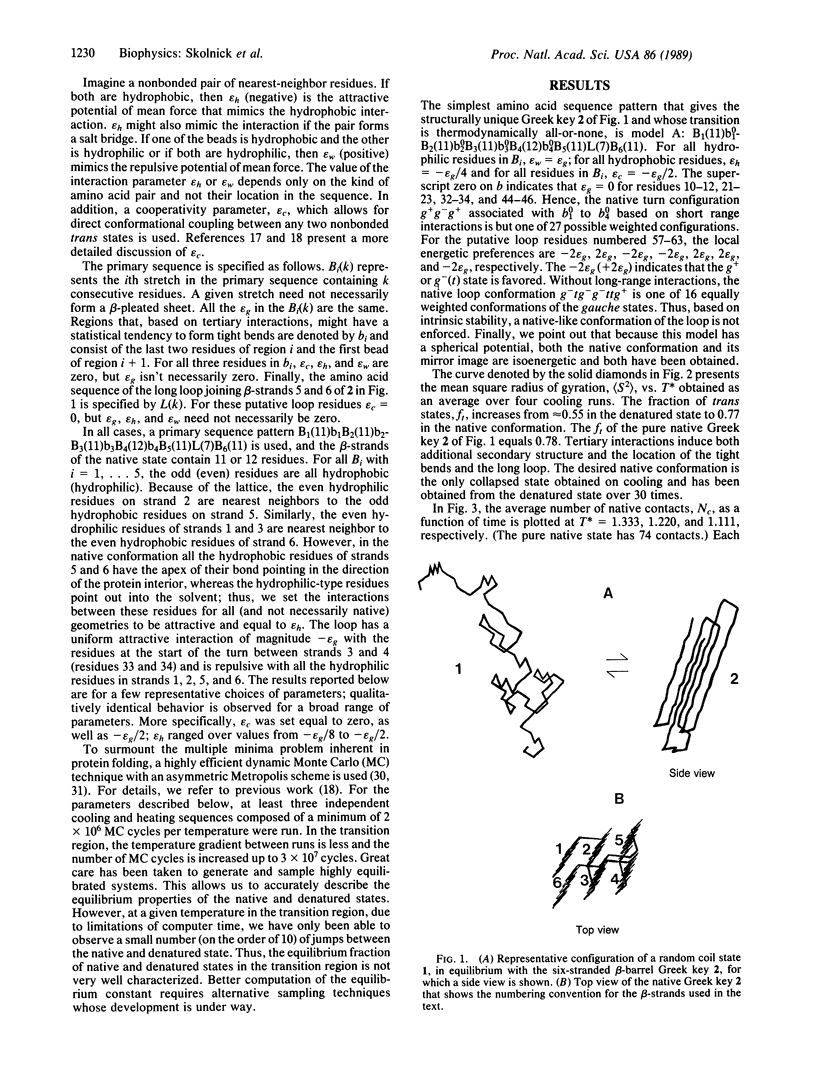
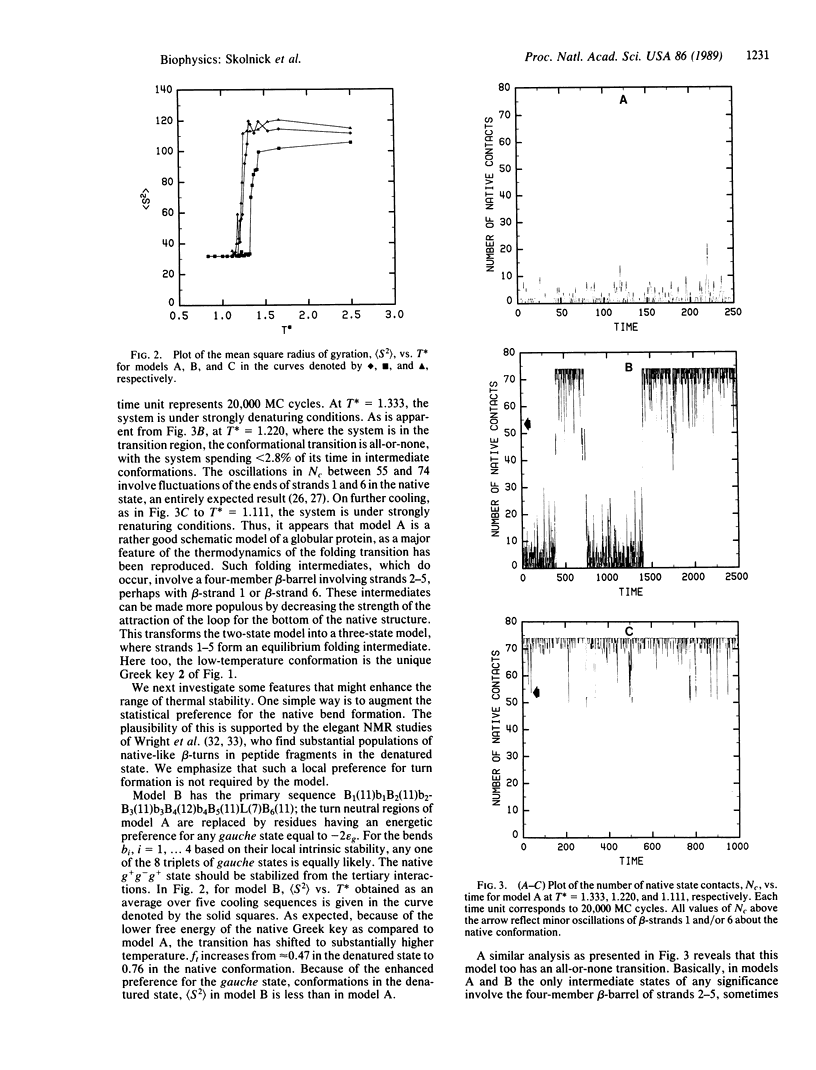
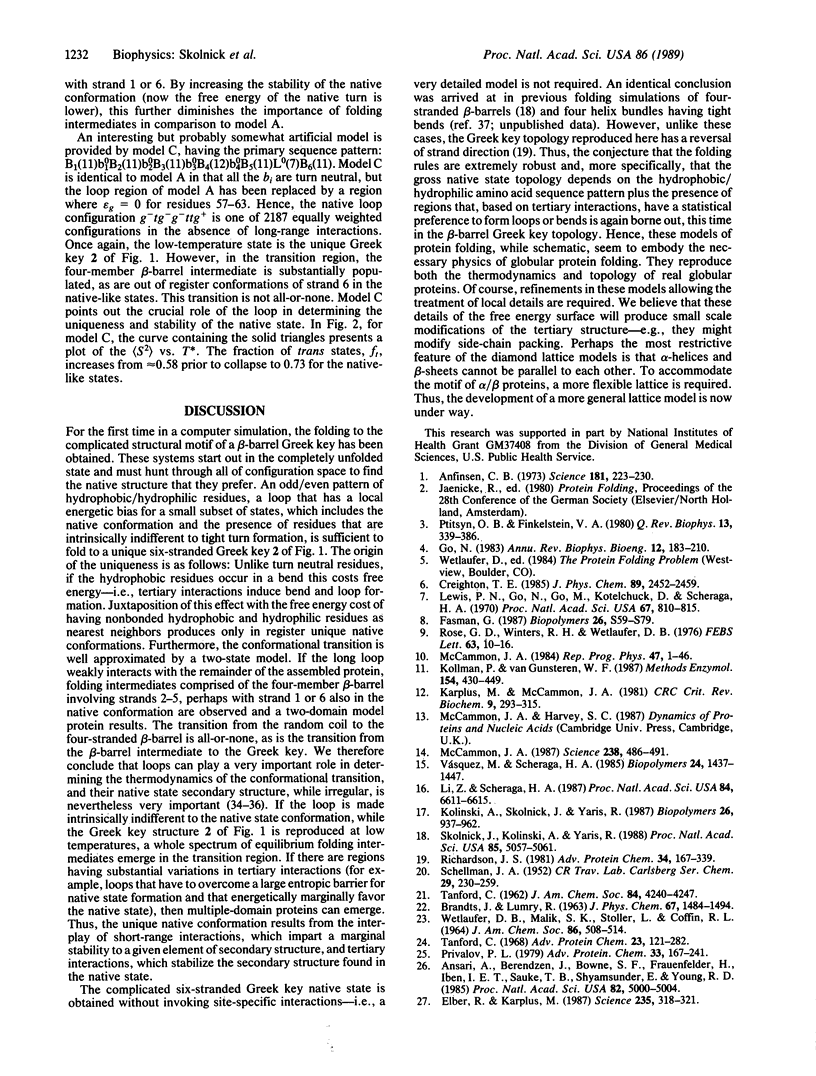
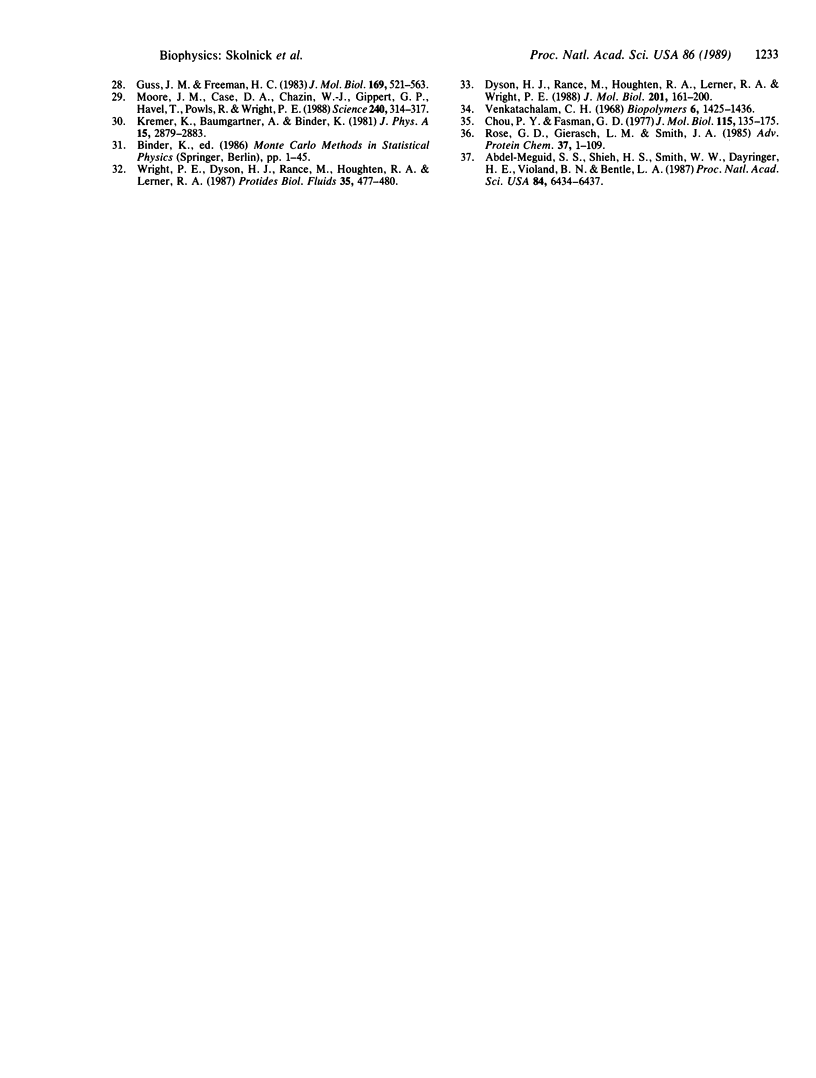
Selected References
These references are in PubMed. This may not be the complete list of references from this article.
- Abdel-Meguid S. S., Shieh H. S., Smith W. W., Dayringer H. E., Violand B. N., Bentle L. A. Three-dimensional structure of a genetically engineered variant of porcine growth hormone. Proc Natl Acad Sci U S A. 1987 Sep;84(18):6434–6437. doi: 10.1073/pnas.84.18.6434. [DOI] [PMC free article] [PubMed] [Google Scholar]
- Anfinsen C. B. Principles that govern the folding of protein chains. Science. 1973 Jul 20;181(4096):223–230. doi: 10.1126/science.181.4096.223. [DOI] [PubMed] [Google Scholar]
- Ansari A., Berendzen J., Bowne S. F., Frauenfelder H., Iben I. E., Sauke T. B., Shyamsunder E., Young R. D. Protein states and proteinquakes. Proc Natl Acad Sci U S A. 1985 Aug;82(15):5000–5004. doi: 10.1073/pnas.82.15.5000. [DOI] [PMC free article] [PubMed] [Google Scholar]
- Chou P. Y., Fasman G. D. Beta-turns in proteins. J Mol Biol. 1977 Sep 15;115(2):135–175. doi: 10.1016/0022-2836(77)90094-8. [DOI] [PubMed] [Google Scholar]
- Dyson H. J., Rance M., Houghten R. A., Lerner R. A., Wright P. E. Folding of immunogenic peptide fragments of proteins in water solution. I. Sequence requirements for the formation of a reverse turn. J Mol Biol. 1988 May 5;201(1):161–200. doi: 10.1016/0022-2836(88)90446-9. [DOI] [PubMed] [Google Scholar]
- Elber R., Karplus M. Multiple conformational states of proteins: a molecular dynamics analysis of myoglobin. Science. 1987 Jan 16;235(4786):318–321. doi: 10.1126/science.3798113. [DOI] [PubMed] [Google Scholar]
- Fasman G. D. The road from poly(alpha-amino acids) to the prediction of protein conformation. Biopolymers. 1987;26 (Suppl):S59–S79. doi: 10.1002/bip.360260009. [DOI] [PubMed] [Google Scholar]
- Go N. Theoretical studies of protein folding. Annu Rev Biophys Bioeng. 1983;12:183–210. doi: 10.1146/annurev.bb.12.060183.001151. [DOI] [PubMed] [Google Scholar]
- Guss J. M., Freeman H. C. Structure of oxidized poplar plastocyanin at 1.6 A resolution. J Mol Biol. 1983 Sep 15;169(2):521–563. doi: 10.1016/s0022-2836(83)80064-3. [DOI] [PubMed] [Google Scholar]
- Karplus M., McCammon J. A. The internal dynamics of globular proteins. CRC Crit Rev Biochem. 1981;9(4):293–349. doi: 10.3109/10409238109105437. [DOI] [PubMed] [Google Scholar]
- Kolinski A., Skolnick J., Yaris R. Monte Carlo studies on equilibrium globular protein folding. I. Homopolymeric lattice models of beta-barrel proteins. Biopolymers. 1987 Jun;26(6):937–962. doi: 10.1002/bip.360260613. [DOI] [PubMed] [Google Scholar]
- Kollman P., van Gunsteren W. F. Molecular mechanics and dynamics in protein design. Methods Enzymol. 1987;154:430–449. doi: 10.1016/0076-6879(87)54089-7. [DOI] [PubMed] [Google Scholar]
- Lewis P. N., Go N., Go M., Kotelchuck D., Scheraga H. A. Helix probability profiles of denatured proteins and their correlation with native structures. Proc Natl Acad Sci U S A. 1970 Apr;65(4):810–815. doi: 10.1073/pnas.65.4.810. [DOI] [PMC free article] [PubMed] [Google Scholar]
- Li Z., Scheraga H. A. Monte Carlo-minimization approach to the multiple-minima problem in protein folding. Proc Natl Acad Sci U S A. 1987 Oct;84(19):6611–6615. doi: 10.1073/pnas.84.19.6611. [DOI] [PMC free article] [PubMed] [Google Scholar]
- McCammon J. A. Computer-aided molecular design. Science. 1987 Oct 23;238(4826):486–491. doi: 10.1126/science.3310236. [DOI] [PubMed] [Google Scholar]
- Moore J. M., Case D. A., Chazin W. J., Gippert G. P., Havel T. F., Powls R., Wright P. E. Three-dimensional solution structure of plastocyanin from the green alga Scenedesmus obliquus. Science. 1988 Apr 15;240(4850):314–317. doi: 10.1126/science.3353725. [DOI] [PubMed] [Google Scholar]
- Privalov P. L. Stability of proteins: small globular proteins. Adv Protein Chem. 1979;33:167–241. doi: 10.1016/s0065-3233(08)60460-x. [DOI] [PubMed] [Google Scholar]
- Ptitsyn O. B., Finkelstein A. V. Similarities of protein topologies: evolutionary divergence, functional convergence or principles of folding? Q Rev Biophys. 1980 Aug;13(3):339–386. doi: 10.1017/s0033583500001724. [DOI] [PubMed] [Google Scholar]
- Richardson J. S. The anatomy and taxonomy of protein structure. Adv Protein Chem. 1981;34:167–339. doi: 10.1016/s0065-3233(08)60520-3. [DOI] [PubMed] [Google Scholar]
- Rose G. D., Gierasch L. M., Smith J. A. Turns in peptides and proteins. Adv Protein Chem. 1985;37:1–109. doi: 10.1016/s0065-3233(08)60063-7. [DOI] [PubMed] [Google Scholar]
- Rose G. D., Winters R. H., Wetlaufer D. B. A testable model for protein folding. FEBS Lett. 1976 Mar 15;63(1):10–16. doi: 10.1016/0014-5793(76)80184-6. [DOI] [PubMed] [Google Scholar]
- SCHELLMAN J. A. The stability of hydrogen-bonded peptide structures in aqueous solution. C R Trav Lab Carlsberg Chim. 1955;29(14-15):230–259. [PubMed] [Google Scholar]
- Skolnick J., Kolinski A., Yaris R. Monte Carlo simulations of the folding of beta-barrel globular proteins. Proc Natl Acad Sci U S A. 1988 Jul;85(14):5057–5061. doi: 10.1073/pnas.85.14.5057. [DOI] [PMC free article] [PubMed] [Google Scholar]
- Tanford C. Protein denaturation. Adv Protein Chem. 1968;23:121–282. doi: 10.1016/s0065-3233(08)60401-5. [DOI] [PubMed] [Google Scholar]
- Venkatachalam C. M. Stereochemical criteria for polypeptides and proteins. V. Conformation of a system of three linked peptide units. Biopolymers. 1968 Oct;6(10):1425–1436. doi: 10.1002/bip.1968.360061006. [DOI] [PubMed] [Google Scholar]
- Vásquez M., Scheraga H. A. Use of buildup and energy-minimization procedures to compute low-energy structures of the backbone of enkephalin. Biopolymers. 1985 Aug;24(8):1437–1447. doi: 10.1002/bip.360240803. [DOI] [PubMed] [Google Scholar]


